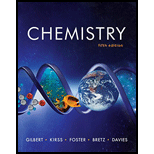
Concept explainers
Interpretation: The amount of ammonium dichromate and potassium chlorate needed to make
Concept introduction: The thermal decomposition of potassium chlorate generates oxygen and decomposition of ammonium dichromate generates pure nitrogen.
To determine: The amount of ammonium dichromate and potassium chlorate needed to make
Answer to Problem 6.83QP
Solution
The amount of
Explanation of Solution
Explanation
Given
The pressure is
The temperature is
The volume of air is
Air is about
Therefore, the volume of
Air is about
Therefore, the volume of
The amount of
Where,
Substitute the value of
The amount of
Where,
Substitute the value of
The decomposition reaction of ammonium chromate is,
According to the above reaction,
The molar mass of
Since
Therefore,
Therefore, the amount of
The oxygen is generated by the thermal decomposition of potassium chlorate.
According to the above reaction,
The molar mass of
Since
Therefore,
Therefore, the amount of
Conclusion
The amount of
Want to see more full solutions like this?
Chapter 6 Solutions
Chemistry: The Science in Context (Fifth Edition)
 ChemistryChemistryISBN:9781305957404Author:Steven S. Zumdahl, Susan A. Zumdahl, Donald J. DeCostePublisher:Cengage Learning
ChemistryChemistryISBN:9781305957404Author:Steven S. Zumdahl, Susan A. Zumdahl, Donald J. DeCostePublisher:Cengage Learning ChemistryChemistryISBN:9781259911156Author:Raymond Chang Dr., Jason Overby ProfessorPublisher:McGraw-Hill Education
ChemistryChemistryISBN:9781259911156Author:Raymond Chang Dr., Jason Overby ProfessorPublisher:McGraw-Hill Education Principles of Instrumental AnalysisChemistryISBN:9781305577213Author:Douglas A. Skoog, F. James Holler, Stanley R. CrouchPublisher:Cengage Learning
Principles of Instrumental AnalysisChemistryISBN:9781305577213Author:Douglas A. Skoog, F. James Holler, Stanley R. CrouchPublisher:Cengage Learning Organic ChemistryChemistryISBN:9780078021558Author:Janice Gorzynski Smith Dr.Publisher:McGraw-Hill Education
Organic ChemistryChemistryISBN:9780078021558Author:Janice Gorzynski Smith Dr.Publisher:McGraw-Hill Education Chemistry: Principles and ReactionsChemistryISBN:9781305079373Author:William L. Masterton, Cecile N. HurleyPublisher:Cengage Learning
Chemistry: Principles and ReactionsChemistryISBN:9781305079373Author:William L. Masterton, Cecile N. HurleyPublisher:Cengage Learning Elementary Principles of Chemical Processes, Bind...ChemistryISBN:9781118431221Author:Richard M. Felder, Ronald W. Rousseau, Lisa G. BullardPublisher:WILEY
Elementary Principles of Chemical Processes, Bind...ChemistryISBN:9781118431221Author:Richard M. Felder, Ronald W. Rousseau, Lisa G. BullardPublisher:WILEY





